These days, almost everyone considering solar and battery storage is wondering if it’s possible to disconnect from the grid altogether; ‘going off-grid’ seems to be all the rage. Just how feasible is it for the average household to go off grid – and is it really worth it?
How easy is it to go off-grid with solar-plus-storage?
The short answer to this question is that unless your electricity usage is minimal (around 5-15 kilowatt-hours per day), it’s not very easy to disconnect from the grid and still have all the comforts (and/or necessities) you’re accustomed to. Even with the cost of solar and energy storage falling, installing batteries really still only makes financial sense in a handful of situations.
If you’re in a major urban centre, deciding whether or not to truly get off the grid should be something you consider very carefully. To do so, you’ll either have to a) significantly change the way that you use electricity (becoming hyper-efficient), or b) spend a significant amount of money on a solar-plus-storage system large enough to get you through a cold, dark winter.
A note about battery storage capacity
Depending on which battery type you’re looking at, the actual usable capacity (usually given in kilowatt-hours, kWh) may be different from the nominal capacity. This is because ‘depth of discharge‘ limitations – not all batteries can be fully discharged without damaging them permanently. In the article below, we are only talking about usable capacity – if you’re shopping around for a battery storage system, make sure you know the difference.
What would it take to go off-grid?
The discussion below is purely about simple numbers – how many kilowatts of solar and how many kilowatt-hours of battery storage capacity would you need at a bare, bare minimum to get off the grid? It doesn’t touch on some of the ‘quality of life’ and other considerations that come along with disconnecting to the grid. We recommend that you check out this 10-point ‘Reality Checklist’ of considerations for those contemplating going off the grid.
But for argument’s sake, let’s say you want to take the plunge and cut all ties with your local network infrastructure. How much solar-plus-storage would you need?
Let’s imagine a home in Sydney and a home in Brisbane. Both have unobstructed, north-facing roofs with plenty of room to put solar panels. On weekdays, both homes use a lot of electricity during the morning and evenings (as per the graph below). What’s the minimum amount of solar and battery capacity these homes would need for basic energy self-sufficiency?
While reading the result below, keep in mind you’d actually want about 3x as much solar & battery storage capacity (or a back-up diesel generator) to ensure you can get through patches of rough weather.
Also remember that all results are indicative. Make sure to consult a qualified solar designer/installer ensure that you get a system that is appropriately sized for your home.
Read more about electricity usage patterns.
Some example scenarios
Sydney: Typical electricity usage scenario
Let’s say your Sydney home uses 20kWh of electricity per day on average throughout the year. At the height of summer, you use 25kWh (because you have AC) and on a typical winter’s day you use 15kWh (you have non-electric heating).
What size system would you probably need? 7kW of solar and about 12kWh of usable battery storage would be the absolute minimum you’d need for daily self-sufficiency (on average).
A snapshot of what basic energy self-sufficiency would look like in Sydney – 7kW of solar and 12kWh of usable battery storage.
Sydney: Low-usage scenario
Let’s say your Sydney home is highly efficient, using only 10kWh of electricity per day on average throughout the year. At the height of summer, you use 15kWh and on a typical winter’s day you use 7kWh (you have non-electric heating).
What size system would you probably need? 4kW of solar and about 7kWh of usable battery storage would be the absolute minimum you’d need for daily self-sufficiency (on average).
A snapshot of what basic energy self-sufficiency would look like for an energy-efficient home in Sydney – 4kW of solar and 7kWh of battery storage.
Brisbane: Typical electricity usage scenario
Let’s say your Brisbane home uses 20kWh of electricity per day on average throughout the year. At the height of summer, you use 25kWh (because you have AC) and on a typical winter’s day you use 15kWh (you have non-electric heating).
What size system would you probably need? 6kW of solar and about 11kWh of usable battery storage would be the absolute minimum you’d need for daily self-sufficiency (on average)
A snapshot of what basic energy self-sufficiency would look like in Brisbane – 6kW of solar and 12kWh of battery storage.
Brisbane: Low-usage scenario
Let’s say your Brisbane home is highly efficient, using only 10kWh of electricity per day on average throughout the year. At the height of summer, you use 15kWh and on a typical winter’s day you use 7kWh (you have non-electric heating).
What size system would you probably need? 3.5kW of solar and about 7kWh of usable battery storage would be the absolute minimum you’d need for daily self-sufficiency (on average).
A snapshot of what basic energy self-sufficiency would look like in Brisbane – 3.5kW of solar and 7kWh of battery storage.
Off-grid living in the city: Dream or reality?
The information above aims to give you an idea of the minimum that would be required for a home to be energy self-sufficient with solar and batteries. As noted above, the reality is that you’d need significantly more capacity to go truly ‘off-grid’ (it’s probably safe to multiply the results in each scenario by 3 to get a better idea) – usually not economically or physically feasible, especially for urban homes with limited roof space for solar panels.
Our aim in publishing this information isn’t to discourage anyone from considering solar-plus-storage for their home, but rather to provide a ‘reality check’ with regard to the feasibility of literally cutting ties with the grid where doing so is not a necessity.
What is apparent from the graphs above is that high degrees of energy self-sufficiency will be possible with solar-plus-storage systems. In particular, it is is not unthinkable for a household to meet its afternoon electricity demand using solar-plus storage – and reduce their energy bills in the process – in Sydney or Brisbane.
Explore the possibility of solar-plus-storage for your home with Solar Choice’s Solar & Battery Storage System Sizing & Payback Estimator tool
Want updates about energy storage? Fill out the form below.
On the back of the success of our informative and impartial Solar Quote Comparisons, Solar Choice is currently in the process of developing an online comparison platform for energy storage solutions – for retrofit and brand new installations. If you’d like to be informed when this new service goes live, please enter your details into the form below and we will be in touch.
© 2016 Solar Choice Pty Ltd
- Solar Power Wagga Wagga, NSW – Compare outputs, returns and installers - 13 March, 2025
- Monocrystalline vs Polycrystalline Solar Panels: Busting Myths - 11 November, 2024
- Solar Hot Water System: Everything You Need to Know - 27 February, 2024
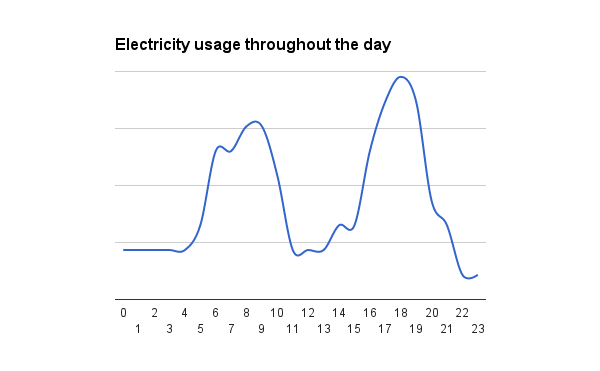

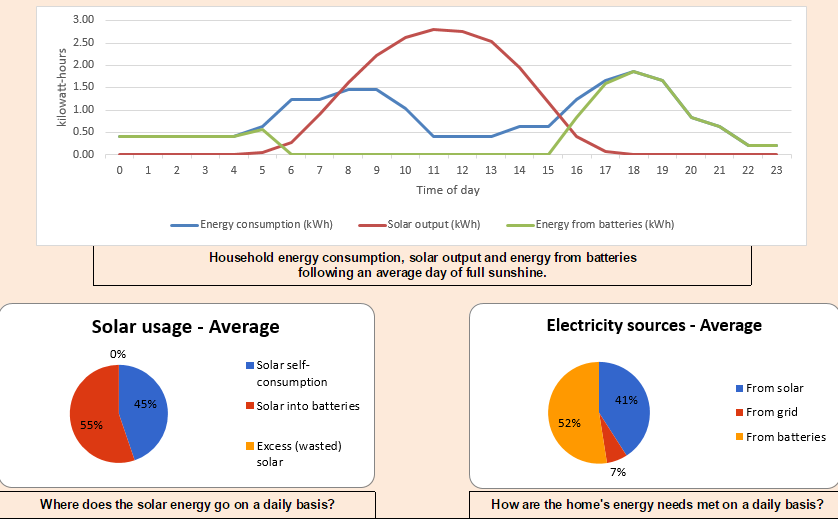

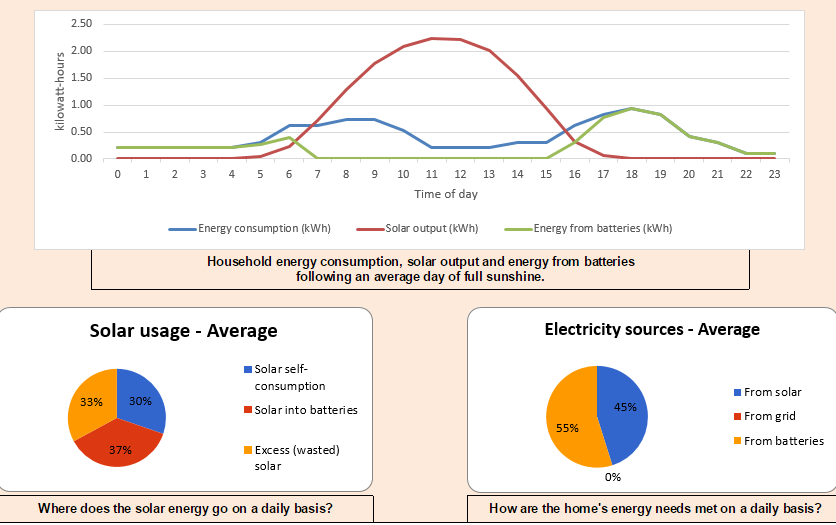

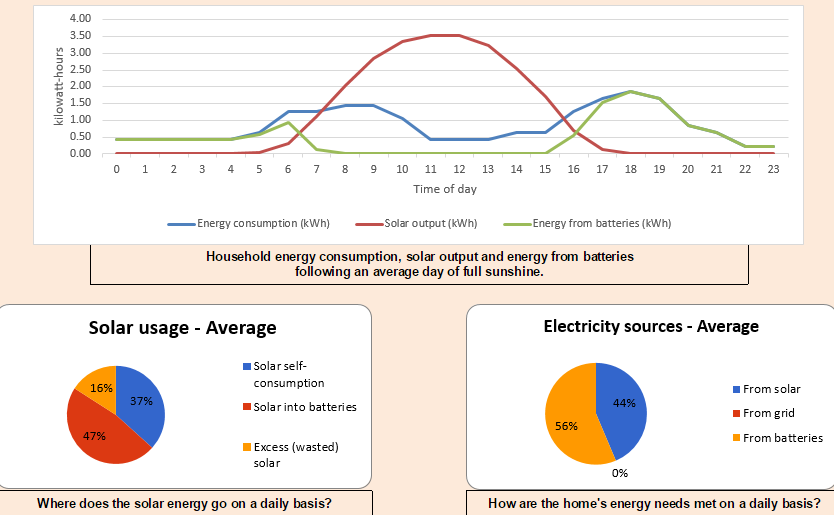

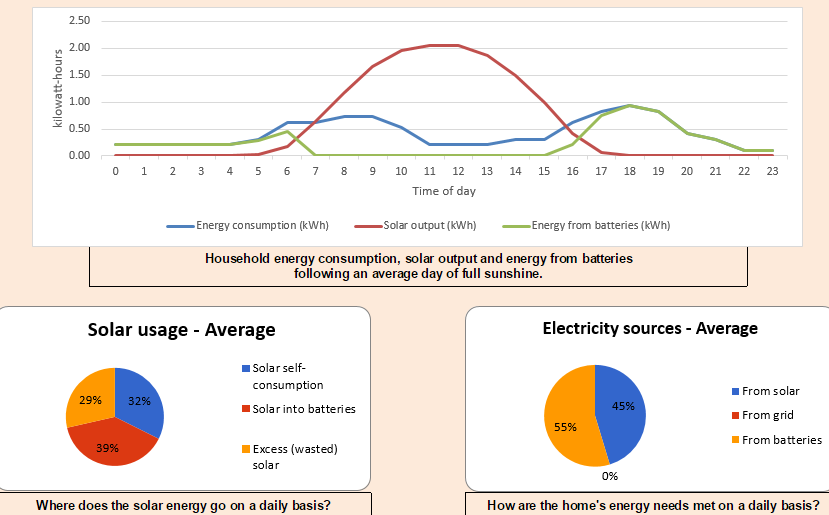
I am looking for someone that can assist with installing solar. I have a 12 panels, 250w each but they are not installed. I want to use 2 panels, 500w 24v, to replace a small 12v system (backup lighting throughout the house, NO inverter, this is a system I can work with safely, and add more lighting, etc.), and 10 panel, 24v system, 2500w to charge batteries to run 50% of the house all power to be converted to 240v.
House uses 6kw power spring / autumn, 11-12kw per day summer / winter. I actually mean, I want the entire house lighting circuit, to run off grid. As well as other circuits. NOT the kitchen, laundry, or the AC. Or I may need additional power points put in. The garage mostly uses low power (fine for solar), but maybe there should be at least one socket run from mains just in case I need to run something that the offgrid system cannot handle.
I estimate the off-grid total usage would be under 3kw per day, and the storage we are looking at is maybe 6kw to 50% My wife does not want our excess power to go to the grid (she claims we will move to a peak / off-peak for power), is there a way the excess from our panels can be used for the rest of the house, and no surplus to the grid?
It is a deal breaker for my wife if she gets moved to a peak / off-peak power plan. I am pretty sure she is better off, but cant get her to see it.
Have not got batteries, inverters, or solar regulators yet. Looking at getting 12x 2v cells, budget will determine how many amps they are. Thinking of getting second hands simply to get the system started
My wife and I will be moving to Kangaroo Island at the end of the year and have designed a house that will be energy efficient including straw bale insulation. We want to go off grid if we can and have been interested in your website. With the development of the second generation Tesla batteries this seems to be feasible but I would be interested in your comments.
Fairly soon the Island’s electricity cable from the mainland will have to be replaced and the company has $45 million to spend. It seems to me that this would be an ideal time to have the whole Island off the main grid and to develop a system of its own. With less than 2,000 households in total and allowing for shops and businesses the $45m would provide enough to provide each property with solar and batteries. Parts of the island are also very and constantly windy. There is already a diesel backup system. What are they waiting for?
Again I would be interested in your comments.
Interesting one, Ian. I’m aware that a project along the lines of what you’re talking about is already underway (with funding from the Australian Renewable Energy Agency) in Bruny Island, Tasmnaia – many parallels with the situation you’re describing. You can read about the project here. I can’t comment too much on the technological aspect of things, but one would think that with a modest subsidy for solar & batteries they could build a self-sufficient microgrid on on the island – possibly spending significantly less than $45m in total. Perhaps the Bruny Island project is something to point towards as an example?
Your battery comparison tool doesn’t appear to cover lead crystal batteries.
How would you rate them? They appear better economically than Z-cells or lithium iron phosphate.
Good question, Milton. Our battery comparison table covers popular products for grid-connected solar systems, and most lead type batteries are better for off-grid. Additionally, the table focuses on brands, while lead batteries of most types are made by multiple manufacturers. We could consider putting together a generic comparison, but may take some time. Thanks for your feedback.
Hi, I am trying to find out if you are able to stop feeding into the grid or have the supply disconnected altogether to go (off grid) after having grid solar installed or are you tied to an agreement that stipulates you need to be connect to the grid as you have received STC, gov rebates etc. I was unable to find anything on this. My electricity provider would be Origin in South East QLD.
All I wish to do is reroute the panels to a second GTI setup for island usage and disconnect output to grid then feed out put to inverter/charger and batteries. When its time to sell, I just reconnect everything to original invert and reconnect output to grid so its back to original install.
Any info greatly appreciated.
Hi Maxwell,
Our understanding is that STCs apply to any accredited solar system regardless of whether it is connected to the grid or not (but you’ll want to confirm with whoever installs your system).
We should also note that even if you do have a system that essentially allows you to be ‘off grid’ and more or less fully energy self-sufficient, retaining a connection to the grid will mean paying a daily supply charge (usually about 80c-$1.30/day depending on where you are and your retailer) regardless of whether you draw any energy from it.
I hope this helps!
Hi Trying to decide mainly what batteries to use off grid. I will be living in Queensland very frugally A 1.5 system would be plenty as my daily use will be approx max 4kw a day Can you please advise battery size and type Hard to choose between gel and salt water for the long run and cost outlay Thank you
Hi Chris,
Unfortunately the fate of Aquion’s saltwater batteries is uncertain, so lead batteries are probably your best bet.
I was wondering if I can install a completely off-grid system in a house in central coast Queensland myself, without needing to use an electrical contractor? I want to run 12V throughout the house using mostly 12v appliances, including fridge, lighting and fans. My wife and I have lived in a caravan for years, much of the time free camping so know about low electricity usage and have lived in another country where electricity was expensive. We don’t use most electrical appliances most people think are essential and our calculated daily use is under 2Kw, since I’m planning on gas or solar hot water and gas cooking, oven etc. I was thinking 1.5Kw PV and 8Kw/hr battery storage. What legal requirements do I have to comply with?
Hi Cooper,
Unfortunately those aren’t questions we know the exact answers to, but it sounds like you are a prime candidate for off-grid living with even a small PV system.
Hi,
I am looking for an off grid system and would like to connect it to a gas backup generator.
My daily consumption is about 15KW per day. Do you think I can go off grid with a 6.24kw solar and a Tesla PowerWall and connect the system to the generator for backup? Would one Powerwall battery be enough or do I need two of them or more?
Thanks,
Hi Sam,
Your consumption is relatively low, but going off grid requires a lot of backup capacity. If you’re doing it for financial reasons, you’ll probably end up paying more in the long run with batteries & a generator. If you’re doing it for environmental reasons, you might want to ditch the generator and go with more solar & battery capacity.
We have an Off-grid Solar & Battery Storage System Sizing Estimator Tool that you can play around with, but keep in mind that it has limitations and is only good for ballpark figures. If you want further details, you’d need to get in touch with some installers (we might be able to help).
Is there any reason you’re thinking about installing a Tesla Powerwall? There are a number of other products out there, some of which are a bit more flexible and/or better suited for an off-grid solar system. Check out our Battery Storage Product Performance Comparison Tool to learn about more.
My daily usage is 30kWh.I currently have a 2Kw system installed,would it be a wise investment to upgrade my system after the feed in tariffs cease at the end of this year.What system output would you recommend i upgrade too?Regards Mark
Hi Mark,
Whether or not you should expand your system depends on a number of factors. (First off – I’m assuming you’re not actually interested in going off grid even though you’ve commented on an article about going off-grid?)
If you’re in NSW, the two first things I’d recommend doing are 1) install some kind of a monitoring system (preferably for solar and your household energy usage), and 2) look around for someone to replace your meter at the end of the year.
The monitoring will allow you to establish what your baseline consumption is and how much of your solar you’re actually likely to be ‘self-consuming‘ (i.e. how much solar energy is produced while you’re running devices in your home?)
The meter change will be necessary to ensure that the solar energy your system produces goes into your home before it goes into the grid. Most solar homes on the Solar Bonus Scheme are on ‘gross’ meters, which means that all of your solar energy goes directly into the grid. After the SBS finishes, that solar energy will be worth much less (about 6-8c/kWh, depending on your retailer), which is why we recommend switching to a ‘net’ meter. A net meter will allow the solar to go first into your home (running your devices and reducing the amount of energy you have to purchase from your retailer in the first place).
You can read more about your options in the run-up to the end of the Solar Bonus Scheme in this article.
As far as expanding your system is concerned, it is possible that it would be worthwhile, especially as solar installation costs have come down significantly since you had your original system installed. Although installing some kind of monitoring would be the first recommendation because it would be more accurate, you’re also welcome to check out our Grid-connected Solar System Sizing Estimator Tool, our Solar & Storage System Sizing Estimator Tool or just go ahead and check out our whole suite of tools here.
Best of luck with your system!
I have 4.6kw panels installed and my total consumption per day is less than 4 kw per day(50% from solar) and less than 2 kw @ night.I am just wondering if i can install an enphase or tesla battery to my present invertor and go off grid. As my 80% of usage bill is supply charge ie around 1.50 $ per day.
Is there any other alternative,which is cost effective?
Hi Dipu,
With such low energy consumption, you’re in a great situation for considering going off-grid. Do you already have solar?
Tesla’s Powerwall is one potential option for you, but as of now the Enphase AC Battery is only for grid-connected systems. You could consider Redflow’s ZCell or Aquion’s ‘saltwater’ batteries. All of these have 7-10 year warranties.
You also may want to seriously consider getting some lead batteries – while not particularly ‘cool’, lead-type batteries have been around for decades and are the stand-by solution for off-grid solar systems.
If you’d like to compare battery prices, feel free to fill out the Quote Comparison Request form to the right of this page. If you already have a solar system just tick ‘battery storage only’ at the top of the form.
You can also give us a call on 1300 78 72 73 if you have any questions.
Best of luck with your system!
If we go off the grid….and we sever all ties with electricity company…do we still have to pay for “Supply Charges” because it is deemed we CAN get electricity and it goes past our property…we are in tamborine qld..acreage.
Hi Sue,
If you actually disconnect from the grid (i.e. no service from the network, even as a backup), then you shouldn’t have to pay supply charges as long as you’ve mentioned this to your supplier. If you’re still physically connected to the grid, however, you’ll still continue to be billed these fixed charges even if you don’t purchase any electricity from the grid (i.e. you’re completely self-reliant with regard to electricity).
We recommend you check in with your electricity retailer to confirm one way or another.
Thank you, that makes sense…..but yes I’ll check, as friends who are on tank water still get charges as the water supply goes past their property even though they are not connected and they were on tank water way before supply went thru…so you just never can tell what these major players try you for….its all getting out of hand with charges for living…they’ll bill us for oxygen next….sorry, off track. Many thanks. Sue
I have an off grid 120sqm home in an Alpine area north of Sydney with 4.5kw solar panels , 1000 ah 12v (6 x 2v) traction wet cell batteries used for 5kwh storage needed per day out of solar hours.The average home consumption is 10kwh per day via a 3/9kw inverter with LPG cooking / hot water and wood for cooking and heating in the cold months. Appliance use is heavy as have the mod cons of a city home , but the appliances are newer ones – not high end but mid range (ie samsung direct drive front load washer , beko fridge ) so find they use little energy. This system using half priced scratch and dent sale solar panels and DIY install ( legal for the solar part as under 120v dc) cost less than $8k and has proven 99.9999 % uptime due dual redundancy design and a 3.4kw inverter auto start petrol genset that runs for 30 hours per annum as triple redundancy and “mushroom growing weather” battery top up. It is also built to the australian standards and has 80ka lightning and surge protection many systems dont have as well as high end industrial Hydraulic magnetic dc circuit breakers sourced as new surplus stock on ebay overseas. Surplus power feeds 2 x 450 watt wall panel heaters and the system has been running flawlessly for 2 years with an ongoing replacement and capital costs of $1 a day for the interest on the capital and $1 a day for the battery and hardware replacement budget and 20 cents a day for the genset fuel and consumables for the annual service. Apart from battery top ups and cleaning the panels and fans in the equipment no other input is required. With the Aussie dollar dropping i belive it would cost $10k in todays money for this system
Hi Phil. It’s great that you managed to get this system up and running yourself – pretty impressive. While we can’t recommend that anyone without proper training should try this at home, we’re also sure that the most intrepid of our readers will do so anyhow. We wish them the best of luck.
It’s actually legal under current australian legislation to diy your own solar if the maxium dc voltage is less than 120 v dc as it’s classed as ELV . If you arrange your open circuit solar panel strings to be less than this (typically no more than 3 in series) and then parallel them then it’s legal.The 240v inverter to house and the house of course have to be installed by an electician.Many out there who have had electronics as a hobby could easily do what i have done safely as we understand DC voltages , insulation , shorts , protection , grounding and high currents well.
Thanks for the insights, Phil!
Should I have a 5 kW unit in Clarence town nsw ? What would be the average feed in tariff ? If I installed batteries for storage , would I be able to run 50 % of my needs? Just two adults in the family. In winter we will,have wood fired slow combustion heaters. Any suggestions and advice ?
Thanks and cheers
Hi Madhab,
Meeting 50% of your electricity needs with solar plus storage is reasonable enough – especially if you have low usage. What’s your daily average kilowatt-hour (kWh) usage at the moment? How about in December and July, when the solar radiation levels are at their highest and lowest, respectively?
As for the feed-in tariff, you’re probably not eligible for much (no one is these days). That means that you’ll want to try to self-consume all of the energy that your panels produce. Without batteries, this means using as much electricity during daylight hours as possible. With batteries, however, you can ‘shift’ some of the solar produced during the day to the evening hours.
I should also advise that you be careful – 5kW may actually be too large for your needs. You don’t want to spend more than you have to!